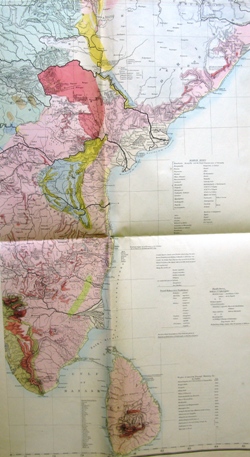
Geoscientist 22.03 April 2012
Visitors to Burlington House will be familiar with George Bellas Greenough’s ‘1819’ (actually 1820) geological map of England and Wales, which hangs in the entrance hall next to the more famous 1815 map by William Smith. Perhaps less familiar to them will be Greenough’s map of India, which was the major achievement of his later years and the first geological map of the entire Indian subcontinent. Printed on nine sheets, with a complete measurement of 3.2 x 2.7 metres, the map is very detailed, particularly in the foothills of the Himalayas.
Greenough did not visit India, but rather, through written correspondence with fellow geologists and military figures, he created the map using their observations from the field, alongside information from his extensive library (much of which now forms the Society’s rare books collection). There was a specific necessity for the map: the East India Company had begun to build the first railways in India in 1850 and good geological information was vital.
The map was published by the Geological Society in 1854, one year before Greenough’s death, and copies were distributed to geological societies around the world. One copy was kept for the Society, but tucked away in the basement are four other copies. Why do we have these? Well, because they were originally destined for countries with which Britain was then at war!
- Historical Map Prints for Sale! - www.geolsoc.org.uk/mapsale
- If you would consider sponsoring the restoration of this map please contact Paul Johnson E:[email protected].
Sponsor-a-Book update
The Library wishes to thank Mr Damon De Laszlo and The De Laszlo Foundation for recently sponsoring the restoration of Richard Owen’s A history of British fossil reptiles (1849 – 1884). The very generous donation allowed us to restore all four volumes, removing rotten sewing while preserving the original buckram cases. For more information on the Sponsor-a-Book Appeal, please visit
www.geolsoc.org.uk/sponsorabook